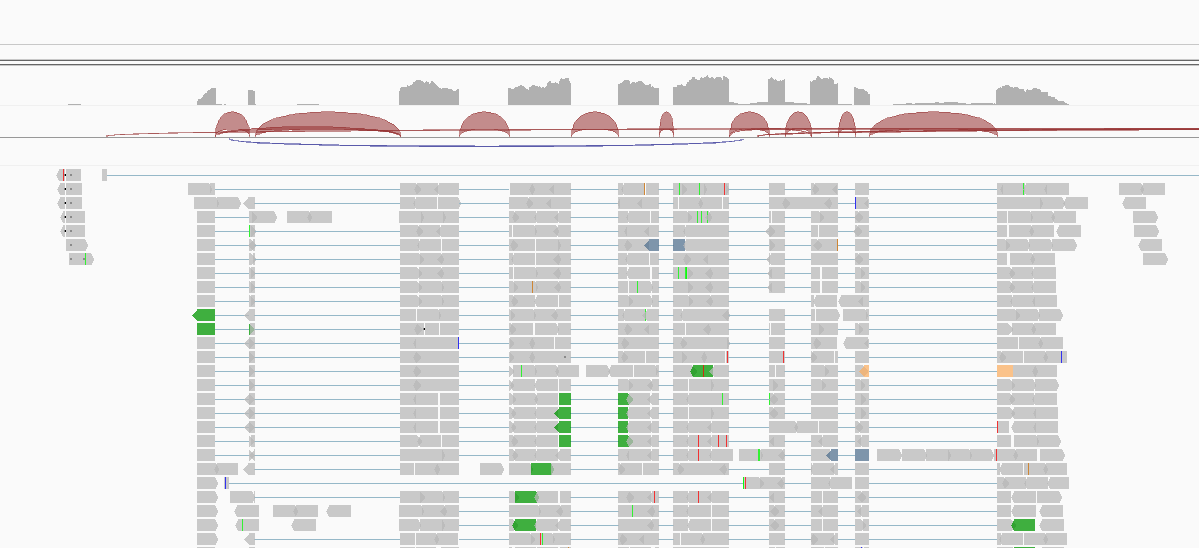Agrosystems Ecology
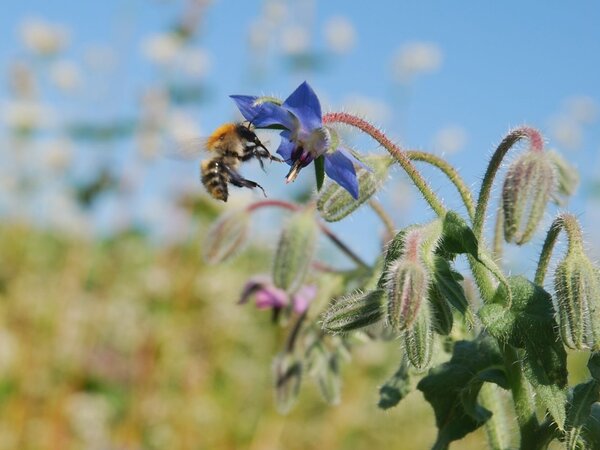
Agricultural systems are home to animals and microorganisms that can ensure environmentally friendly usability through their communal activity. The positive ecosystem services such as pollination or soil fertility are typically promoted by a high level of biodiversity, which remains stable even under extreme environmental conditions such as heat, drought, heavy rain or storm events. Insects, soil animals and soil microorganisms are particularly important in agricultural systems.
Soil animals and microorganisms enable the formation of fertile soil aggregates by decomposing plant residues and building up organic matter. Microorganisms store unused nitrogen from fertilisers or dispose of it as a harmless gas. Leftover pesticides are degraded microbiologically. To promote the positive biological effects and control the negative ones, we are investigating how different management systems affect soil life and how the highest possible soil fertility can be ensured by protecting the soil biological resource.
For microbiological analyses, the Institute uses the new potential of soil metagenome analyses, in which DNA is sequenced using high-throughput methods and interpreted bioinformatically. By examining individual soil aggregates, we have recently been able to make previously hidden interaction patterns and regulatory processes visible.
Our soil zoological studies focus on the function and performance of soil animal communities in different land use systems. Using earthworm communities as an example, we relate ecological groups and their specific casts systems to soil water balance. Fungivorous soil animals serve us as key organisms for improving soil health by regulating soil-borne phytopathogenic fungi and their toxins.
Alternative crop rotations, e.g. through the cultivation of legumes, intercropping, mixed crops and combined forms with cover crops, allow agricultural land to be used in a more soil-friendly way with less use of pesticides. We are investigating how diversified cropping systems, above and below ground, affect the diversity of insects, soil animals and microorganisms and their ecosystem services.
Responsible scientists:Jens Dauber, Stefan Schrader, Brandon Seah, Christoph Tebbe, Jan Thiele
Current topics
Microbial communities are diverse and changeable in time and space - how do individual organisms come together to form a community and how do they respond to a changing environment? We are investigating this in various research projects
Responsible scientists: Christoph Tebbe
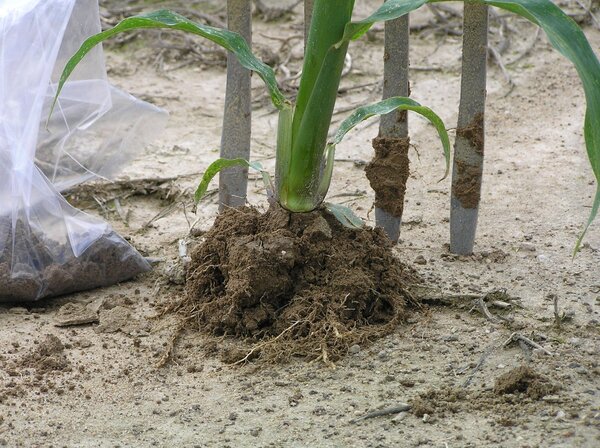
The microbiome is the central motor for the conversion of organic matter in soils, through which biogeochemical cycles and other important ecosystem services are ultimately maintained. However, the importance of biodiversity for these services is still poorly understood. This severely limits predictions of changes in microbial diversity and services at the field level and beyond. Our research aims to characterise the implications of energy and matter fluxes on the diversity and complexity of microbial communities in order to achieve a better, systems-based understanding of how soils microbiologically process energy and matter. Data will be collected through complex soil column experiments in an interdisciplinary collaboration with university and non-university research institutions.
The ecosystem services of microbial communities are the result of the functional potentials of their diverse members. Under the specific living conditions in the rhizosphere, microorganisms are selected that, on the one hand, promote plant growth in order to meet their demand for energy-rich carbon compounds through root release, but on the other hand, there is competition for the uptake of nutrients from the soil, especially nitrogen (N) and phosphorus (P). This ambivalence can be understood as positive or negative feedbacks between the plant and the microbial communities. We characterise the functional diversity of microbial communities in the rhizosphere in response to root properties and soil conditions such as drought, compaction and contact zone to the root. We are looking at alternative genetic versions for key functions of soil N transformations and P mobilisations from aggregate soil DNA. Our focus on N transformation and P mobilisation will provide a new understanding of positive and negative feedback effects between plants, soil and microorganisms.
In general, the higher the microbial biomass in soils, the higher their capacity to provide ecosystem services. The growth of microorganisms in agricultural soils is often limited by a lack of energy-rich carbon, which can be provided via plant residues, when there is an excess of nitrogen from residual fertiliser. But other factors, such as the lack of micronutrients like manganese, magnesium, iron or zinc, could also play an important role in building up microbial biomass in soils. We support this research taking place at the Rhine-Waal University with our expertise in soil metagenome analyses.
The importance of soil microbiomes as carriers of ecosystem functions and thus as an important element of sustainable agriculture is undisputed today. But how do new technologies, such as the cultivation of genetically modified crops or the use of virus-based plant protection products, affect the diversity and function of soil microbiomes? Should soil microbiomes be a protected good?
Responsible scientists: Christoph Tebbe
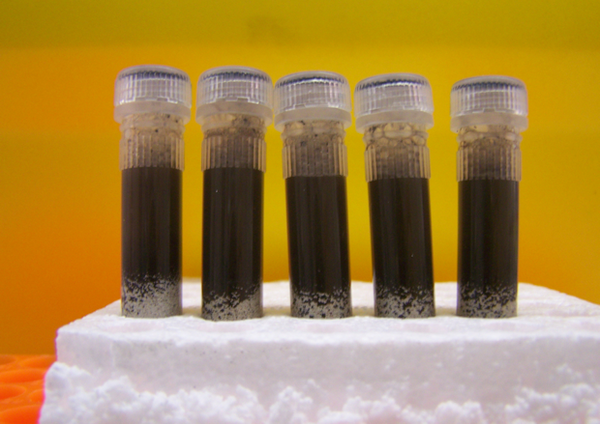
Agriculture is constantly changing in order to optimise its productivity and in response to current and expected demands on its production. The implementation of new technologies and products cannot always rely on empirical knowledge to assess environmental impacts before commercialisation. Due to the importance of microbiomes for ecosystem services, we are therefore conducting studies on the impact of new technologies on soil- and plant-associated microbiomes. We are not necessarily looking for single organisms at species level as indicators, but mainly want to understand how microbiomes change, e.g. by replacing single species or reorganising links between different species. These parameters can be determined on the basis of soil metagenome analyses.
It is also a question of whether the soil microbiome should be used as a protected good for the assessment of new technologies in the future. For environmental risk assessments, as they are carried out in the EU or other parts of the world, the microbiome has not played a role as a protected good in approval procedures to date.
Viruses and bacteriophages (bacterial viruses) are increasingly being considered as an environmentally friendly alternative to chemical pesticides in agriculture. Using the example of bacteriophages for the control of plant-pathogenic bacteria, we investigated to what extent related non-target organisms could also be affected and thus microbiomes on phage-treated plants and soils could change unintentionally. Our results so far show a high specificity of the phages for the target organisms and no further effect on microbiomes.
Soil aggregates are temporally and spatially dynamic units that represent the immediate habitat for most soil microorganisms. Effects of environmental changes on the structure and functional organisation of microbiomes could best be detected here if one had the techniques to do so. Important methodological limitations to be able to use this scale to provide information have been developed by us in recent years.
Respinsible scientists: Christoph Tebbe

Every soil contains DNA and thus also the genetic material of the organisms that live or have lived in it. This is primarily the DNA of the microorganisms. Thanks to the high-throughput DNA sequencing available today, this genetic information, the so-called metagenome, can be recorded and at least partially decoded.
Metagenomes are usually obtained from about one gram of soil. However, this quantity disregards the structural properties that define the soil habitat for microorganisms. This is because soils consist of primary mineral, organo-mineral and organic particles that form aggregates under the influence of physico-chemical but also biological factors. Soil aggregates are thus associations of living microorganisms, organic material in different stages of decomposition, and mineral particles.
The specific living conditions in aggregates and on their surfaces have a decisive influence on how a soil functions and what services it performs at the ecosystem level and beyond. The biological activity of aggregates is controlled not only by the organisms they contain, but also through physico-chemical interactions with abiotic components. These aggregates are small and vary greatly even within a gram of soil.
The term "aggregates", which we developed, considers soil aggregates as functional biological units. These units are temporally and spatially dynamic and control the flow of energy and substrate in soils. "Aggregatomics" aims to capture the totality of biological components qualitatively and quantitatively independent of individual organisms. These can be information-bearing macromolecules, i.e. nucleic acids (DNA, RNA) and proteins, or microbial metabolic products. In our current work, we analyse the microbial communities of aggregates at the DNA level to elucidate biological diversity and microbial interactions.
The aggregates can also be manipulated experimentally, e.g. by adding growth factors and monitoring the response of the microbiomes to this intervention. With this approach, we have now succeeded in proving that mutual growth promotion holds microbiomes together. One bacterial species supplies its neighbours with an important amino acid, which means that these neighbours can afford to forego the energy-intensive production of this nutrient. This leads to a division of labour within the microbiome and thus to its stabilisation.
Agricultural use constantly changes the living conditions for soil microbiomes. We investigate and compare the influence of monocultures, simple crop rotations and spatially and temporally diversified cropping systems on soil microbiomes, also paying special attention to the influence of variable site-specific soil properties.
Responsible scientists: Christoph Tebbe
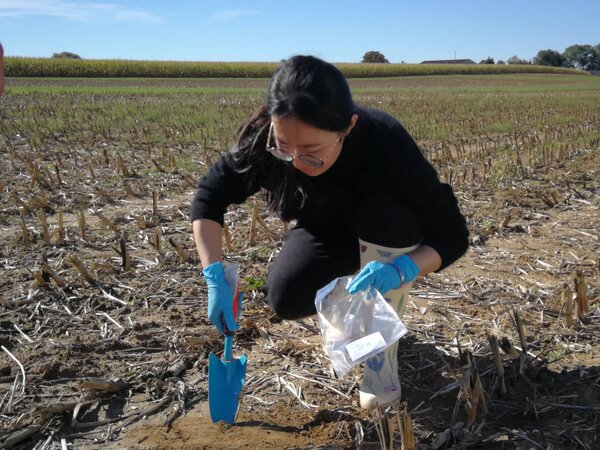
Soil microbiomes require energy-rich nutrients for their reproduction, which primarily come from plants. These substances can be released by growing plants into the soil via the roots, creating the so-called rhizosphere, or it is released from plant residues in the course of biodegradation. Every plant species, including our cultivated plants such as maize, wheat or potatoes, secrete a cocktail of different substances in the rhizosphere that is typical for them, so that plant-specific microbiomes with different compositions are formed. In monocultures, the same bacteria and fungi species are always promoted, which leads to an impoverishment of microbial diversity. In contrast, crop rotations and, even more so, diversified systems with cover crops or the simultaneous cultivation of different crops lead to increased microbial diversity. This also increases the stability of the microbiomes and their ability to store nutrients or to suppress pathogenic soil microorganisms.
We have already shown that similar but not identical bacterial communities congregated in the rhizosphere of maize at different locations in Europe, i.e. the location and associated characteristic soil properties also contributed to the diversity of microorganisms. In a long-term field experiment, we showed that intercrops stabilised the microbial community over winter, so that the crops following in spring had better starting conditions. While crop rotations influenced the diversity of dominant soil microorganisms as expected, the incorporation of organic residues into the soil over a period of several decades mainly had a positive influence on the less dominant species, which can, however, make an important contribution to soil fertility and whose survival is ensured by soil organic matter.
The high energy content and valuable nutrients in agricultural waste, especially in animal excreta, offer the possibility of producing biogas, and thus an important energy source, in an environmentally friendly way through anaerobic fermentation. The conversion processes are carried out by complexly composed microbiomes, which, however, do not always exhibit optimal efficiency. The key to increasing this efficiency is a deeper understanding of microbiological functions and their regulation. Metagenome analyses offer a completely new and profitable approach to this.
Responsible scientists: Christoph Tebbe
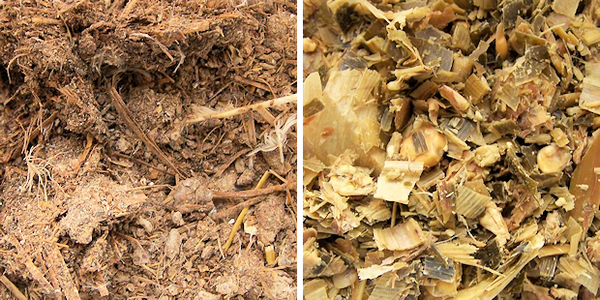
The function of biogas plants is based on the close interaction of different bacteria and archaea in the decomposition of organic substrates and their conversion into the energy carrier methane gas. For this purpose, agricultural waste products such as excrement from farm animals are to be used in a value-added manner. However, the use of chicken excrement, for example, is problematic due to the associated input of ammonia and the increase in the pH value in the biogas plants. High pH values inhibit the microbiomes and lead to a drastic reduction or complete standstill of microbial biogas synthesis. We are investigating how ammonia-tolerant microbiomes can be enriched so that they are still able to produce biogas. Analyses of the composition of these communities using metagenomics will provide important information on how to manage more efficient biogas reactors at high pH values in the future.
Eukaryotic unicellular organisms, so-called protists, are widespread but little known. Compared to multicellular plants and animals, protists are microscopic and therefore easy to overlook. Compared to prokaryotes (e.g. bacteria), their genomes are more complex, and all the more difficult to sequence or analyse. In collaboration with external cooperation partners, we conduct research especially on species groups relevant to soil or aquatic habitats, e.g. the ciliates.
Responsible scientists: Brandon Seah
Eukaryotic microorganisms (also called "protists"), e.g. ciliates and amoebae, are much richer than plants and animals in both diversity and numbers. Their abundance in soil and aquatic habitats makes them promising ecological indicator species, but their own ecological roles are poorly understood. In the literature, they are often characterised only as "bacterial predators", although they can interact with other species in different roles, e.g. as predators, parasites, hosts, and symbionts. In addition, there is little genomic reference data from protists. Therefore, they are easily overlooked in metagenomic studies that rely on comparisons with reference data. Metabarcoding studies using PCR methods may also underestimate the species diversity of protists, as primer sequences are based on pre-existing reference sequences.
Therefore, we aim to lay the foundation for documenting the biodiversity of eukaryotic microorganisms by participating in genome projects for relevant species, namely testate (shelled) amoeba and ciliates. By structurally and functionally annotating their genes, we enable the prediction of their metabolism and ecological role, especially on the questions:
- How are the genomes of different protists structured?
- How do they interact with other organisms in the community, e.g. symbiosis?
- To what extent are protists suitable as indicator species? Is the data basis sufficient for this?
Earthworms shape the soil profile through their burrowing activity, thereby providing important ecosystem services for the yield security of utilised soils. We are investigating the genesis and function of the burrow systems and loosening aggregates as a contribution to soil fertility.
Responsible Scientists: Stefan Schrader
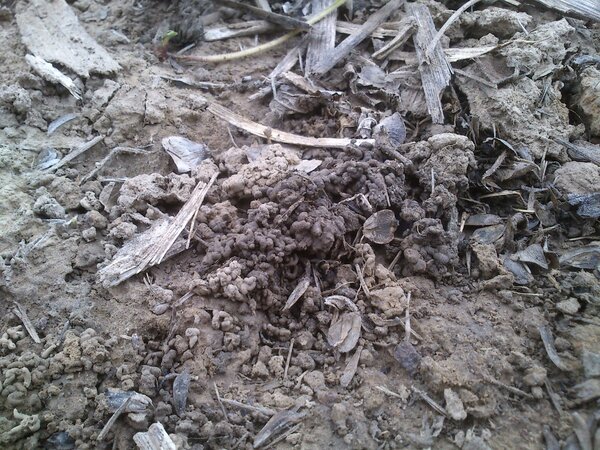
Earthworm communities contribute in different ways to shaping the soil profile and controlling soil functions, depending on the site. In arable soils, it is the deep-digging earthworm species that primarily control the infiltration capacity of the soil, the water flow and thus the water balance. Their contribution to the formation of new aggregates in the soil profile is rather small, because they primarily deposit their looseness on the soil surface. On the other hand, shallow-digging earthworm species, which build network-like tunnels in the topsoil and partially fill them with their looseness, primarily contribute to the formation of new aggregates in the soil profile. With regard to the water balance of the soil, their burrowing pattern results in a retention of soil water, i.e. water storage. The challenge for field research is to understand the relationship between the ecological composition of a site's earthworm community and the soil processes that occur in the soil profile under agricultural management.
In practical farms, we have already been able to measure the direct correlation between earthworm community composition and water infiltration for annual and perennial energy crop stands. Building on the results and experience gained, in the next step we will analyse earthworm communities and water fluxes in the soil at the landscape scale in so-called living labs. Based on a spatial grid and using a colour tracer, the water-bearing pore fractions in the field will be determined.
The retention of organic matter from crop residues on the soil surface promotes soil biodiversity, but also favours the development of phytopathogenic fungi. Fungivorous soil animals have a key function here for the biological self-regulation in the used topsoil. We are investigating the antagonistic mechanisms of soil animal activity as a contribution to soil health.
Responsible scientists: Stefan Schrader
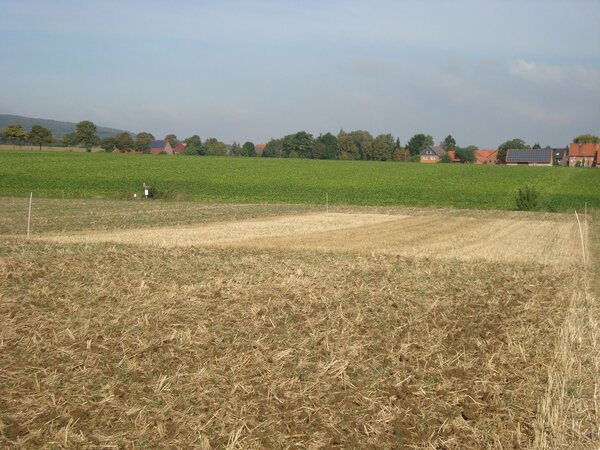
Sustainable soil management for soil protection often includes leaving organic residues on the soil surface. This form of soil cover serves, among other things, to protect against erosion, reduce evaporation (evaporation from the soil surface) and stabilise the soil microclimate near the surface. At the same time, this creates an attractive settlement substrate for soil-borne harmful fungi. Fusarium fungi are among the economically important harmful organisms worldwide, because their infestation leads to yield losses and contaminates the harvested crop by producing toxins (here: mycotoxins), thus damaging it as food or feed or even making it unusable. Here we are investigating the role of fungivorous soil animals as antagonists in reducing infection and to what extent they contribute to the degradation of mycotoxins.
So far, we have analysed and quantified the bioregulation of Fusarium and its toxins for fungivorous earthworms, enchytraeids and collembolae. The bioregulatory performance was investigated and evaluated taking into account external effect factors such as time, temperature, texture and chaff size. It was shown that synergy can occur between agricultural management (top-down effects) and natural bioregulation (bottom-up effects). Building on this, our next step is to pursue the goal of promoting this bioregulatory potential of fungivorous soil animals through innovative management measures and at the same time counteracting an increased input of plant protection products. To this end, we are working together with farmers in practical farms.
By diversifying cropping systems, the contribution of biodiversity with its ecosystem services to agricultural production can be managed with a view to environmentally friendly and re-source-conserving land use. From an agroecological perspective, we develop and test inno-vative cropping systems to promote and use the diversity of soil animals, above-ground ar-thropods and flower-visiting insects and their functions and services.
Responsible scientists: Jens Dauber, Stefan Schrader, Christoph Tebbe
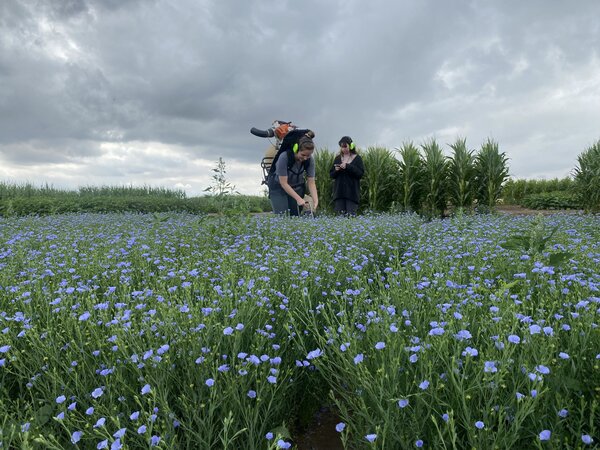
We investigate and evaluate the performance of alternative crop rotations, intercropping, mixed cropping and combined forms of crop diversification in different soils and climatic conditions compared to conventional cropping systems. Diversification is often also accompanied by adaptations in tillage and crop protection. Our research questions are:
- How do diversified cropping systems affect soil microbiological diversity and its ecosystem services?
- Which organisms and groups of organisms are promoted, inhibited or extinguished?
- Can conclusions be drawn from changes in microbial performance at the process level in small scales (e.g. soil aggregates) for higher scales (field, landscape, climate zones) up to global change?
- How do diversified farming systems affect the species number and abundance of natural counterparts (especially epigean predatory arthropods)?
- Which arthropods are promoted, which are inhibited?
- How do these changes affect pest control?
- Are savings in crop protection and fertilisation possible with crop diversification and what effect does this have on natural counterparts and their performance?
- What are the consequences of integrating energy crops (especially perennial crops) into cropping systems for food production?
- Do diversified cropping systems with flowering crops, undersown crops or catch crops (e.g. legumes) increase the nectar and pollen supply and does this promote flower-visiting insects?

![[Translate to English:] [Translate to English:]](/media/_processed_/e/3/csm_Demetra2_c8a192c0f8.jpg)
![[Translate to English:] [Translate to English:]](/media/_processed_/e/2/csm_Demetra1_Panorama_8557ee3b13.jpg)
